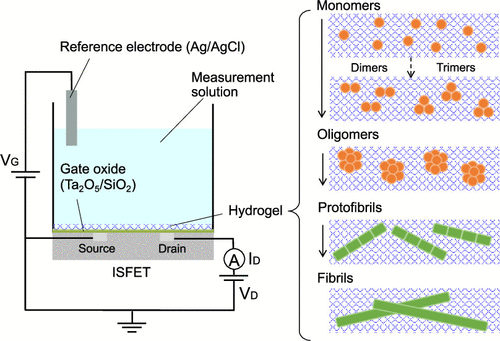当前位置:
X-MOL 学术
›
Anal. Chem.
›
论文详情
Our official English website, www.x-mol.net, welcomes your
feedback! (Note: you will need to create a separate account there.)
Hydrogel-Coated Gate Field-Effect Transistor for Real-Time and Label-Free Monitoring of β-Amyloid Aggregation and Its Inhibition
Analytical Chemistry ( IF 6.7 ) Pub Date : 2022-02-04 , DOI: 10.1021/acs.analchem.1c04339 Toshiya Sakata 1 , Reiko Shiratori 1 , Masaru Kato 2
Analytical Chemistry ( IF 6.7 ) Pub Date : 2022-02-04 , DOI: 10.1021/acs.analchem.1c04339 Toshiya Sakata 1 , Reiko Shiratori 1 , Masaru Kato 2
Affiliation

|
In this paper, we propose a hydrogel-coated gate field-effect transistor (FET) for the real-time and label-free monitoring of β-amyloid (Aβ) aggregation and its inhibition. The hydrogel used in this study is composed of poly tetramethoxysilane (TMOS), in which Aβ monomers are entrapped and then aggregate, and coated on the gate insulator; that is, Aβ aggregation is induced in the vicinity of the sensing surface. With the Aβ hydrogel-coated gate FET, the steplike decrease in the surface potential of the Aβ hydrogel-coated gate electrode is electrically monitored in real time, according to the stepwise aggregation of Aβ monomers to form into fibrils through oligomers and so forth in stages. This is because the capacitance of the Aβ-hydrogel membrane decreases depending on the stage of aggregation; that is, the hydrophobicity of the Aβ-hydrogel membrane increases stepwise depending on the amount of Aβ aggregates. The formation of Aβ fibrils is also confirmed in the measurement solution using a fluorescent dye, thioflavin T, which selectively binds to the Aβ fibrils. Moreover, the addition of daunomycin, an inhibitor of Aβ aggregation, to the measurement solution suppresses the stepwise electrical response of the Aβ hydrogel-coated gate FET. Thus, a platform based on the Aβ hydrogel-coated gate FET is suitable for a simple screening system for inhibitors of Aβ aggregation, which may lead the identification of potential therapeutic agents for Alzheimer’s disease.
中文翻译:

用于实时和无标记监测 β-淀粉样蛋白聚集及其抑制的水凝胶涂层栅极场效应晶体管
在本文中,我们提出了一种水凝胶涂层栅极场效应晶体管 (FET),用于实时和无标记监测 β-淀粉样蛋白 (Aβ) 聚集及其抑制。本研究使用的水凝胶由聚四甲氧基硅烷(TMOS)组成,其中Aβ单体被包埋然后聚集,并涂覆在栅极绝缘体上;即,在传感表面附近诱导 Aβ 聚集。使用 Aβ 水凝胶涂层栅极 FET,根据 Aβ 单体逐步聚集通过低聚物等阶段形成原纤维,实时电监测 Aβ 水凝胶涂层栅极电极表面电位的阶梯式下降. 这是因为 Aβ-水凝胶膜的电容会随着聚集阶段的不同而降低。那是,Aβ-水凝胶膜的疏水性根据 Aβ 聚集体的量逐步增加。Aβ 原纤维的形成也在使用荧光染料硫代黄素 T 的测量溶液中得到证实,该染料选择性地结合到 Aβ 原纤维上。此外,将 Aβ 聚集抑制剂道诺霉素添加到测量溶液中可抑制 Aβ 水凝胶涂层栅极 FET 的逐步电响应。因此,基于 Aβ 水凝胶涂层栅极 FET 的平台适用于 Aβ 聚集抑制剂的简单筛选系统,这可能导致识别阿尔茨海默病的潜在治疗药物。它选择性地与 Aβ 原纤维结合。此外,将 Aβ 聚集抑制剂道诺霉素添加到测量溶液中可抑制 Aβ 水凝胶涂层栅极 FET 的逐步电响应。因此,基于 Aβ 水凝胶涂层栅极 FET 的平台适用于 Aβ 聚集抑制剂的简单筛选系统,这可能导致识别阿尔茨海默病的潜在治疗药物。它选择性地与 Aβ 原纤维结合。此外,将 Aβ 聚集抑制剂道诺霉素添加到测量溶液中可抑制 Aβ 水凝胶涂层栅极 FET 的逐步电响应。因此,基于 Aβ 水凝胶涂层栅极 FET 的平台适用于 Aβ 聚集抑制剂的简单筛选系统,这可能导致识别阿尔茨海默病的潜在治疗药物。
更新日期:2022-02-04
中文翻译:

用于实时和无标记监测 β-淀粉样蛋白聚集及其抑制的水凝胶涂层栅极场效应晶体管
在本文中,我们提出了一种水凝胶涂层栅极场效应晶体管 (FET),用于实时和无标记监测 β-淀粉样蛋白 (Aβ) 聚集及其抑制。本研究使用的水凝胶由聚四甲氧基硅烷(TMOS)组成,其中Aβ单体被包埋然后聚集,并涂覆在栅极绝缘体上;即,在传感表面附近诱导 Aβ 聚集。使用 Aβ 水凝胶涂层栅极 FET,根据 Aβ 单体逐步聚集通过低聚物等阶段形成原纤维,实时电监测 Aβ 水凝胶涂层栅极电极表面电位的阶梯式下降. 这是因为 Aβ-水凝胶膜的电容会随着聚集阶段的不同而降低。那是,Aβ-水凝胶膜的疏水性根据 Aβ 聚集体的量逐步增加。Aβ 原纤维的形成也在使用荧光染料硫代黄素 T 的测量溶液中得到证实,该染料选择性地结合到 Aβ 原纤维上。此外,将 Aβ 聚集抑制剂道诺霉素添加到测量溶液中可抑制 Aβ 水凝胶涂层栅极 FET 的逐步电响应。因此,基于 Aβ 水凝胶涂层栅极 FET 的平台适用于 Aβ 聚集抑制剂的简单筛选系统,这可能导致识别阿尔茨海默病的潜在治疗药物。它选择性地与 Aβ 原纤维结合。此外,将 Aβ 聚集抑制剂道诺霉素添加到测量溶液中可抑制 Aβ 水凝胶涂层栅极 FET 的逐步电响应。因此,基于 Aβ 水凝胶涂层栅极 FET 的平台适用于 Aβ 聚集抑制剂的简单筛选系统,这可能导致识别阿尔茨海默病的潜在治疗药物。它选择性地与 Aβ 原纤维结合。此外,将 Aβ 聚集抑制剂道诺霉素添加到测量溶液中可抑制 Aβ 水凝胶涂层栅极 FET 的逐步电响应。因此,基于 Aβ 水凝胶涂层栅极 FET 的平台适用于 Aβ 聚集抑制剂的简单筛选系统,这可能导致识别阿尔茨海默病的潜在治疗药物。













































 京公网安备 11010802027423号
京公网安备 11010802027423号